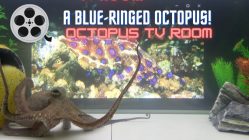
When you think about octopuses, an idealized or conceptualized image pops into your head almost immediately. It is that of a sea creature with a large head, expressive eyes, and eight long arms.
Depending on your level of knowledge of marine life, this image may be no more detailed than that. In essence, the majority of people are imagining the common octopus (scientific name octopus Vulgaris) when picturing octopuses.
Vulgaris Octopus Facts
- Scientific Name : Vulgaris Octopus
- Common Name: Common Octopus
- Size: about 1m (3-4 ft)
- Weight: 5 – 10kg (11 – 22 pounds)
- Lifespan: 2 years
- Found in: Mediterranean Sea, Atlantic Ocean, Pacific and Indian Oceans
- Sub-Order: Incirrina
- Discovered: 1797
- Scientific Name : Vulgaris Octopus
- Common Name: Common Octopus
- Size: about 1m (3-4 ft)
- Weight: 5 – 10kg (11 – 22 pounds)
- Lifespan: 2 years
- Found in: Mediterranean Sea, Atlantic Ocean, Pacific and Indian Oceans
- Sub-Order: Incirrina
- Discovered: 1797
It would not be a stretch to state that the octopus Vulgaris is the main representative of all octopuses to us humans. They are the ambassadors for all octopods, so to speak.
—Overview—

Even when octopuses are represented in artistic form or in popular culture — such as in cartoons — most of those representations are also modeled on the common octopus.
It would not be a stretch to state that the octopus Vulgaris is the main representative of all octopuses to us humans. They are the ambassadors for all octopods, so to speak.
With that being the case, it would be beneficial to know more about them. What do they share in common with other octopus species? Where can they be found? You know, the nitty-gritty of being an octopus Vulgaris.
—What Is an Octopus Vulgaris?—
Like the rest of the over 300 octopus species, the octopus Vulgaris is a mollusk. More specifically, it is a species within the Octopoda taxonomical order. It belongs to the class known as cephalopods. The latter also includes their evolutionary “cousins” — squid and cuttlefish.
—Size of the Common Octopus—

The common octopus is considered to be a medium-sized octopus. It can grow to a length of over four feet and weigh up to 22 pounds. However, the average size of a fully grown octopus Vulgaris is slightly over three feet and they weigh in at an average of 12 to 15 pounds.
—Worldwide Distribution of the Common Octopus—
The octopus Vulgaris obtained its popular name due to its proliferation around the world. While its presence as the most abundant octopus species is in the Mediterranean Sea and the eastern Atlantic Ocean, it can also be found in areas of the Pacific and Indian Oceans. The common octopus can also be found in large seawater inlets such as the Red Sea.
Scientifically, the octopus Vulgaris is classified as a tropical and subtropical species.
—Habitat of the Common Octopus—

The common octopus prefers to live in shallower coastal waters. They will normally be found in depths ranging from 300 to 450 feet to just a few dozen feet when tidal pools or coral reefs are involved. Rarely will they be found in water deeper than that.
Usually, the warmer the water temperature, the deeper water that the common octopus will seek. This means that during the autumn and winter months they will have a greater tendency of being found at shallower depths. The common octopus does not inhabit waters which are frigid.
Regardless of what region of the world’s oceans the common octopus inhabits, it will always make its individual home in sheltered dens. Usually, these will be crevices and other openings along the substrate of the waters that they inhabit.
Dangers in Their Habitat
By spending most of their time in protected dens, the common octopus is able to avoid potential predators. Unfortunately, one of its predators uses the knowledge that common octopuses like to seek out such small and well-protected dwellings in order to catch them. We are talking about humans.
One of the most effective methods used to catch common octopuses is to lay octopus pots on the sea floor. These are plastic or metal bucket-like containers attached to a line leading to the surface. Prior to the mid-20th century, clay pots were commonly used.
The pots are left on the seafloor for extended periods of time in hopes of a common octopus coming along and moving in. During daytime hours, when the octopus is more prone to be home, the pots are pulled up and the octopuses collected. It would be sort of like space aliens hovering over your house as you are relaxing watching TV and pulling your house up with a tractor beam — with you in it. Once in their spacecraft, you would then be eaten. (Hope that image doesn’t stir up some nightmares for you later.)
—Reproduction of the Octopus Vulgaris—

Like all octopus species, the common octopus will only mate once in its life. Each female will produce and lay between 50,000 and 200,000 eggs.
Of these eggs, it is estimated that less than one percent make it to full adulthood.
—How the Common Octopus Defends Itself—
One of the most effective defensive mechanisms of the common octopus is its ability to camouflage itself in plain sight. Even though it prefers to live in seclusion inside a secured den, it can also find safety when out in the open by blending into its surroundings.
It accomplishes this by having specialized cells on the surface of its skin which change color to match its immediate surroundings. Specialized muscle cells on the skin also help in matching the texture of the surrounding area.
When cornered or surprised by a potential predator out in the open, the common octopus will secrete a stream of ink to confuse its attacker and escape.
—Behavior Patterns of the Common Octopus—

The common octopus is a solitary creature. As adults, they live alone. The only time that they venture outside of their den is when they emerge to hunt for food or when they feel the need to relocate their den due to a perceived danger.
While they are solitary creatures, the common octopus is also curious. In the wild, marine biologists have discovered the presence of certain sea mollusk species previously unknown to inhabit the area simply by analyzing the piles of debris which collect in front of common octopus dens.
When the common octopus hunts, it prefers to bring its food back to its den where it will consume it. When the octopus is finished, it discards the undigestable remnants outside of its den opening.
It is in this trash pile that marine biologists have discovered species of sea mollusks that they were unaware of as residing in the immediate area. This means that the common octopus actually explores its immediate environment motivated primarily by a search for food. This requires a level of curiosity that many other sea creatures do not possess.
In an indirect way, it also means that the common octopus has been of invaluable assistance to marine biologists in determining the precise composition of ocean fauna for a specific area. You might say that the octopus Vulgaris is an amateur marine biologist in its own right.
—What Does the Common Octopus Eat?—

Bearing in mind that the common octopus is found across so many different regions of the world’s oceans, it should be no surprise that it is able to adapt its a diet to regional conditions. This means that the common octopus will feast upon bivalve mollusks and crustaceans that are indigenous to its home.
Generally speaking, the common octopus prefers shrimp, crabs, lobsters, clams, and mussels. It is, however, not out of the ordinary for the common octopus to also eat small fish.
—Hunting Style of the Octopus Vulgaris—

The octopus Vulgaris does the majority of its hunting between the hours of the dusk and dawn. This is the time when it emerges from its den and actively seeks out prey.
This is not to say that the common octopus does not venture out to during daytime hours when it detects a target of opportunity. For example, if an unsuspecting crustacean were to wander near the octopuses den, the octopus will take the opportunity to grab a quick snack.
When the common octopus ventures out of its den to hunt, it prefers to walk or crawl along the seafloor using its arms. Even though the common octopus is able to achieve relatively fast speeds darting through the water by siphoning streams of water from its funnel, it only does so sparingly.
When hunting is involved, its preferred method is to use stealth and to apply a pouncing technique on its prey at the last second. Its high-speed dashes through the water are primarily reserved when the octopus has to escape danger.
Immobilizing and Eating Its Prey
When a common octopus catches its prey, it immediately begins a process of immobilizing it. This is accomplished by injecting a toxin into the prey.
When the common octopus comes across a creature that it wants to eat, it will pounce on it and grab it with its arms. Sometimes, the common octopus will use its arms to extract prey that is hidden inside small crevices or hiding behind rocks.
The arms of the common octopus are lined with suction cups. These serve two purposes. One, they provide the common octopus with a strong mechanism to grab and hold prey. Second, since they are lined with sensory organs, the common octopus can literally taste what it touches.
This provides the octopus Vulgaris with the ability to grab on to potential prey and immediately determine if it is worth eating or not. When it is, the strong arms and powerful grip of its suction cups will bring the captured prey immediately to its mouth.
The Mouth and Beak

The mouth of the common octopus, just as with all other octopus species, it’s located at the base of its head underneath its body where all eight of its arms converge. This positioning is very convenient as it can bring prey immediately to its mouth from any of its eight arms.
Near the base of its head, the eight arms of the common octopus are connected by a webbing of skin. This further assists the common octopus in hunting by shrouding the captured prey as it brings it to its mouth.
Once the octopus Vulgaris has brought the prey to its mouth, it immediately uses its beak to pierce the captured creature. It then injects the toxin into their system. This toxin, although not too deadly to humans, immediately paralyzes mollusks, crustaceans, and fish.
The beak of the common octopus is the only hard part of its entire body. It is rigid and strong enough to pierce through the exoskeleton of arthropods and also powerful enough to force open the shells of bivalve mollusks.
By immobilizing its prey immediately upon capture, the common octopus is able to minimize the amount of struggling that is involved. Once the creature has been rendered motionless — something which takes just a few seconds — the common octopus then begins to inject digestive enzymes into the creature.
—Intelligence and Cognition of the Common Octopus—

Being so numerous, a lot of what is known about octopuses, in general, comes from professional and amateur observation of the common octopus species.
Both in the wild and in captivity, the octopus Vulgaris displays numerous signs of intelligence and advanced cognition. Individual specimens have been known to escape from holding tanks which seemed secured in the eyes of their human handlers. Common octopuses have been observed to analyze their enclosures and to methodically locate weaknesses which they then exploit to escape.
Other specimens of the octopus Vulgaris have been observed conducting complex tasks. These include removing the lids from jars or unlatching boxes. In these observations, the common octopus displays an innate ability to analyze a problem and to construct a solution. That requires a level of intelligence and cognition that is not common among other invertebrates.
The common octopus also displays signs of enjoying a form of play. Usually, the act of playing is associated only with animals that have developed levels of intelligence. Think along the lines of your family dog or pet cat. They play to keep their bodies and minds fit and also to develop and sharpen their natural skill sets.
—How Abundant is the Common Octopus?—

Covering such vast areas of the oceans, it should be no surprise that the population of the common octopus is large.
By analyzing the tonnage of common octopuses that are caught by fishermen on a yearly basis, you can begin to get an idea of their number. Just in the Eastern Atlantic and Mediterranean, approximately 20,000 tons of common octopuses are collected from the sea every year. Worldwide, it is estimated that half of the octopus that is consumed by humans is made up of the common octopus species.
Being so prolific, the octopus Vulgaris is not on any endangered species list.
—Can I Keep a Common Octopus as a Pet?—
If you are an octopus pet beginner and you are trying to figure out which species you will like to adopt, then the common octopus is a highly recommended species. A tank with a 50 gallons capacity will be sufficient for a young individual, but if you have the space and resources, a 100 gallons tank will be more ideal. As far as water temperature is concerned, although the common octopus can survive in a wide range of temperatures, they thrive at about 15 to 16 °C.
One advantage of the common octopus is that it is not a very picky eater. It will even feed on frozen fish. Feeding time is primarily dusk and dawn and the best time to observe your pet friend is during the night.
—In Short, the Common Octopus Is Successful—
When you consider their numbers and the range which they inhabit, the common octopus can be considered to be a very successful species.
Thanks to their success, we have been able to learn more about them and their fellow octopus species. Their presence in such close proximity to human populations has allowed us to gain an ever-expanding knowledge and respect for all octopuses in general.











